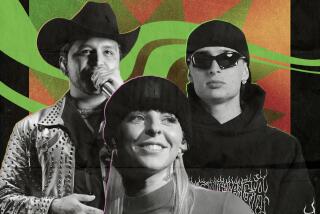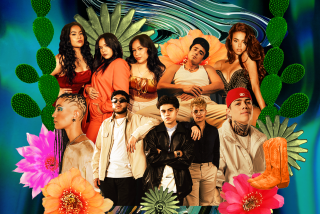Puerto Vallarta’s not just for tourists, it’s for artists too
PUERTO VALLARTA, Mexico -- Strollers passing along the river that flows through downtown here were startled last week to encounter a pair of “Towel Swans” gliding atop the murky water. Crafted out of plastic foam by Chilean artist Cristián Silva, they resembled the decorative birds sculpted by chambermaids to be left on tourists’ hotel beds, in hopes of earning a few extra pesos in tip money.
The “swans” briefly drifted on Saturday afternoon but were retrieved after a few urgent cellphone calls. As to how those stealthy avians got there in the first place, the answer was simple: Provocateurs were in town.
It’s been 4 1/2 decades since director John Huston and company came here to shoot “The Night of the Iguana” and placed this former fishing village on the map. But Puerto Vallarta still conjures up Hollywood-style tropical fantasies that lure cruise ships and charter-jet tourists by the tens of thousands every year.
Never mind that this Pacific coast resort has a population of nearly 200,000 or that its growth has produced a slew of inconvenient truths: dirty water, trash-strewn beaches, crime, gridlocked Saturday-night traffic and eco-unfriendly hotels and condominiums. Plus the annual bacchanal of sunburned coeds and frat boys gone wild whom Mexicans refer to as los spring breakers.
Last week, a small but energetic group of artists, writers, curators and other cultural savants from Los Angeles, Guadalajara, Tijuana and Mexico City joined the locals in hopes of adding a new, positive attraction to the area. “Puerto Vallarta Arte Contemporáneo 08,” a five-day marathon of art shows, panel discussions, walking tours and public art projects, was the inaugural edition of a contemporary art festival that organizers hope will become an annual event. The idea of attaching an art fair, jazz fest or film symposium to a beach resort is hardly novel, but few, if any, of Mexico’s principal beach resorts have gotten in on the act yet.
“There is a great deal of potential because of the richness of Puerto Vallarta,” Aurelio López Rocha, tourism secretary for Jalisco state, one of the festival’s sponsors, said while puffing on a cigar at a Saturday night after-party. “I think Puerto Vallarta can position itself at a high level.”
Festival Director Pilar Perez, a veteran L.A. arts programmer and Puerto Vallarta native, sees the project as a means of enhancing the growing cross-border dialogue among artists, patrons and cultural institutions across California and Latin America. She also thinks that developing a larger, richer contemporary art scene could help her hometown develop an identity not based solely on sun, surf and commercial development. “I still really love this place, but I’m very scared about what could be here,” she said.
At present, Puerto Vallarta doesn’t lack for art. Plein-air painters display their idealized oceanscapes along the Malecón pedestrian sidewalk. And there are plenty of folkloric tchotchkes for sale at the many souvenir stands.
But there’s a much less developed tradition here of contemporary art, with its high-concept abstractions, patchwork materials and ironically subversive humor. Trying to make these art traditions mesh was among the challenges facing festival participants, along with keeping your ceviche from spilling on your laptop.
The out-of-town delegation included Tijuana artist Marco Ramirez Erre; Ruben Ortiz-Torres, a Mexico City native turned Echo-Park-er; and Sandra de la Loza, Ruben Ochoa and Mario Ybarra Jr., all from L.A., and all represented in Los Angeles County Museum of Art’s ongoing exhibition “Phantom Sightings: Art After the Chicano Movement.” LACMA assistant curator Rita González, Museum of Contemporary Art associate curator Alma Ruiz and L.A.-Mexico City journalist-blogger Daniel Hernandez also were on hand.
Many artworks were displayed at a nexus of galleries in the city’s downtown, two of them owned by Omar Alonso Vazquez, who moved here from Guadalajara several years ago. A critical mass of artists, galleries and collectors has been building in the area for some time, Alonso said. All that has been needed is a festival to “lift art in Puerto Vallarta to an international level.”
Fittingly, a number of works addressed themes of globalization and borders (political, aesthetic, technological), while challenging the host city’s touristic raison d’être. Davis R. Birks, a Seattle native who has lived in Puerto Vallarta for years, displayed his witty sculpture “US/ELLOS,” a double-sided cyclone fence that makes a visual pun of the abbreviation for “United States” and the Spanish word for “them.” Ortiz-Torres’ video, “Nuevo Vallarta” (2008), depicted the former World Trade Center towers looming over the fast-developing Puerto Vallarta shoreline, a haunting image of how foreign money and power can transform a landscape and a way of life.
The ambitious panel discussions tackled such themes as how the folk-craft and contemporary art can be better integrated and how culture changes when formerly “minority” cultures turn into the majority. Some discussions took place in unconventional public spaces, such as an outdoor plaza and the gay nightclub Mañana. Alejandro Serratos, 29, who lives near the club, suggested that the longtime rapport between the city’s large gay community and gay tourists could serve as a model for mixing local and foreign artists.
“I think it’s very important above all for the people of Puerto Vallarta to understand what contemporary art is,” he said.
Participants also batted around ideas about how to make Puerto Vallarta more “green” and amenable to sustainable development so it doesn’t turn into another traffic-congested, over-built resort. Feedback was generally friendly and constructive, though some said they wished more local artists and institutions had been included in the festival. “In a way, this friction is important in order to grow,” Birks said.
More to Read
Sign up for The Wild
We’ll help you find the best places to hike, bike and run, as well as the perfect silent spots for meditation and yoga.
You may occasionally receive promotional content from the Los Angeles Times.







